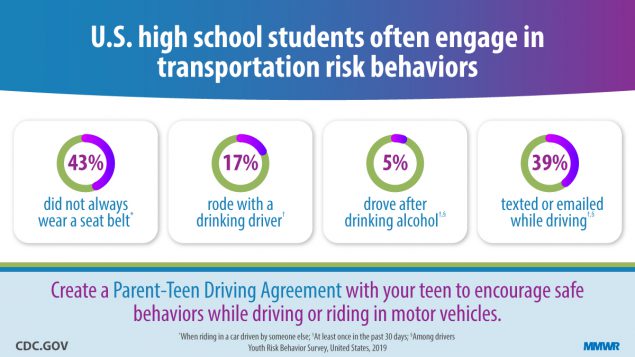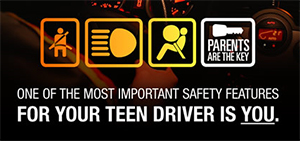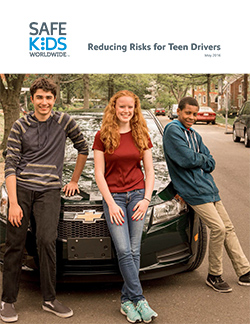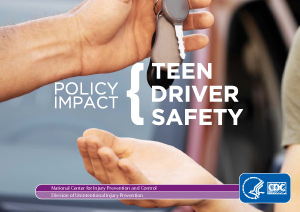Publications
Teen crash fatality rates differ by geographic location. Data from 2015 and 2017 national Youth Risk Behavior Surveys were combined and analyzed to explore the role of census region and metropolitan status for driving prevalence and four transportation risk behaviors among U.S. public high school students. This study found:
- 41% of students did not always wear a seat belt. Students in the Northeast were 40% more likely than students in the Midwest to not always wear a seat belt.
- Among the 75% of students (aged ≥16 years) who drove, 47% texted/e-mailed while driving during the 30 days before the survey. Students in the Northeast were 20% less likely than students in the Midwest to text/e-mail while driving. Students attending suburban or town schools were 20%–30% more likely to text/e-mail while driving than students attending urban schools.
- 19% of students rode with a driver who had been drinking alcohol during the 30 days before the survey, and 7% of students (aged ≥16 years) who drove did so when they had been drinking alcohol, with no differences by location for either behavior.
There were few differences in teen transportation risk behaviors by geographic location. Factors such as age at licensure, time since licensure, driving experience, and the policy and physical driving environment might contribute more to variation in teen crash fatality rates by geographic location than differences in teen transportation risk behaviors.
Motor vehicle crash injuries are a leading cause of death and nonfatal injury among adolescents. In 2019, 43.1% of U.S. high school students did not always wear a seat belt as a passenger, and 16.7% rode with a driver who had been drinking alcohol during the past 30 days. Of the approximately 60% of students who drove a car during the past 30 days, 5.4% drove after drinking alcohol, and 39.0% texted or e-mailed while driving at least once during the past 30 days. Also, students engaging in one transportation risk behavior were more likely to engage in other transportation risk behaviors. Reducing risky transportation behaviors among adolescents by using proven strategies (e.g., primary enforcement seat belt laws, publicized sobriety checkpoints, and parent-teen driving agreements) can help prevent crashes, reduce injuries, and save lives.

- Shults RA, Shaw KM, Yellman MA, Jones SE. Does geographic location matter for transportation risk behaviors among U.S. public high school students?external icon. J Transp Health 2021;22:101134. doi:10.1016/j.jth.2021.101134
- Shults RA, Jones JM, Komatsu KK, Sauber-Schatz EK. Alcohol and marijuana use among young injured drivers in Arizona, 2008–2014external icon. Traffic Inj Prev 2019;20(1):9–14. doi:10.1080/15389588.2018.1527032
- Li L, Shults RA, Andridge RR, Yellman MA, Xiang H, Zhu M. Texting/Emailing While Driving Among High School Students in 35 States, United States, 2015external icon. J Adolesc Health 2018;63(6):701–708. doi:10.1016/j.jadohealth.2018.06.010
- Shults RA, Bergen G, Smith TJ, Cook L, Kindelberger J, West B. Characteristics of Single Vehicle Crashes with a Teen Driver in South Carolina, 2005–2008external icon. Accid Anal Prev 2019;122:325–331. doi:10.1016/j.aap.2017.08.002
- Shults RA, Williams AF. Trends in teen driver licensure, driving patterns and crash involvement in the United States, 2006–2015external icon. J Safety Res 2017;62:181–184. doi:10.1016/j.jsr.2017.06.013
- Jewett A, Shults RA, Bhat G. Parental perceptions of teen driving: Restrictions, worry and influenceexternal icon. J Safety Res 2016;59:119–123. doi:10.1016/j.jsr.2016.09.003
- Shults RA, Haegerich TM, Bhat G, Zhang X. Teens and seat belt use: What makes them click?external icon. J Safety Res 2016;57:19–25. doi:10.1016/j.jsr.2016.03.003
- Haegerich TM, Shults RA, Oman RF, Vesely SK. The Predictive Influence of Youth Assets on Drinking and Driving Behaviors in Adolescence and Young Adulthoodexternal icon. J Prim Prev 2016;37(3):231–245. doi:10.1007/s10935-016-0418-7
- Shults RA, Banerjee T, Perry T. Who’s not driving among U.S. high school seniors: A closer look at race/ethnicity, socioeconomic factors, and driving statusexternal icon. Traffic Inj Prev 2016;17(8):803–809. doi:10.1080/15389588.2016.1161761
- Shults RA, West BA. ATV riding and helmet use among youth aged 12–17 years, USA, 2011: results from the YouthStyles surveyexternal icon. Inj Prev 2015;21:10–14. doi:10.1136/injuryprev-2013-041138
- Shults RA, Williams AF. Trends in driver licensing status and driving among high school seniors in the United States, 1996–2010external icon. J Safety Res 2013;46:167–170. doi:10.1016/j.jsr.2013.04.003
- Yellman MA, Bryan L, Sauber-Schatz EK, Brener N. Transportation Risk Behaviors Among High School Students — Youth Risk Behavior Survey, United States, 2019. MMWR Suppl 2020;69(Suppl-1):77–83. doi:10.15585/mmwr.su6901a9
- Shults RA, Williams AF. Graduated Driver Licensing Night Driving Restrictions and Drivers Aged 16 or 17 Years Involved in Fatal Night Crashes — United States, 2009–2014. MMWR Morb Mortal Wkly Rep 2016;65:725–730. doi:10.15585/mmwr.mm6529a1
- Shults RA, Olsen EO, Williams AF. Driving Among High School Students — United States, 2013. MMWR Morb Mortal Wkly Rep 2015;64(12):313–317.
- Shults RA, Olsen EO. Vital Signs: Drinking and Driving Among High School Students Aged ≥16 Years — United States, 1991–2011. MMWR Morb Mortal Wkly Rep 2012;61(39):796–800.
Parents Are the Key to Safe Teen Driving

Parents Are the Key, a campaign from the Centers for Disease Control and Prevention (CDC), helps parents, pediatricians, and communities keep teen drivers safe on the road.
Reducing Risks for Teen Drivers

Safe Kids Worldwide report “Reducing Risks for Teen Drivers” explores how families are managing the risks new drivers face and suggests strategies that families can put into place to help keep teen drivers safe.
The Policy Impact: Teen Driver Safety brief was published in October 2010. Therefore, this web page is provided for reference purposes only. The most current CDC data can be found on the Teen Drivers: Get the Facts page.
The Insurance Institute for Highway Safety GDL rating system featured on the last page of the Policy Impact document is no longer in use.

Teen motor vehicle crashes are preventable. There are proven policies to improve the safety of young drivers on the road.
Download the Policy Impact: Teen Driver Safety pdf icon[PDF - 8 pages] brief to learn more.